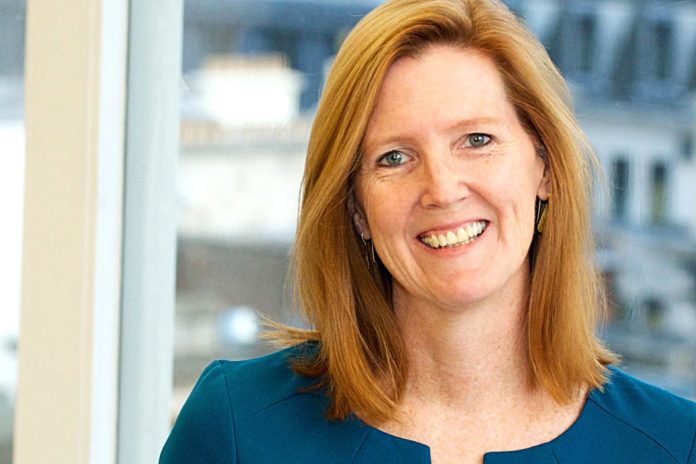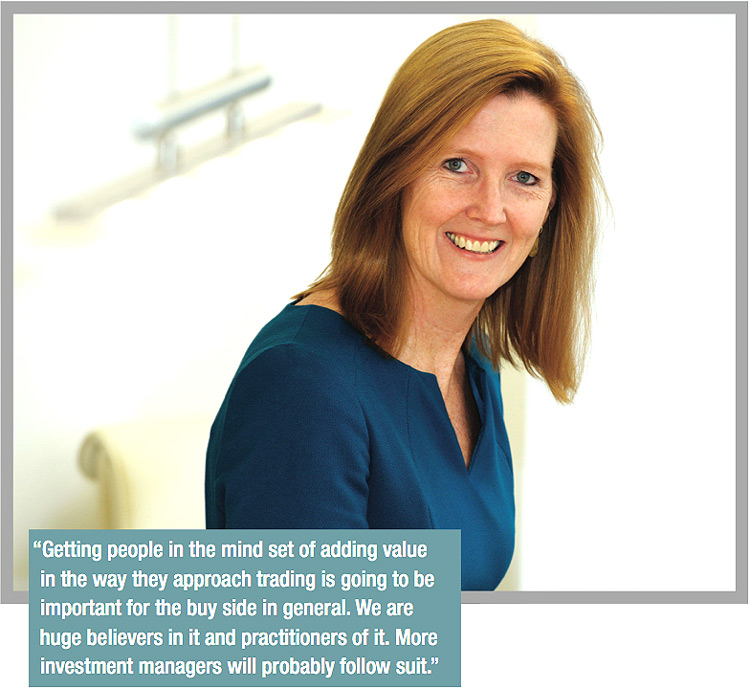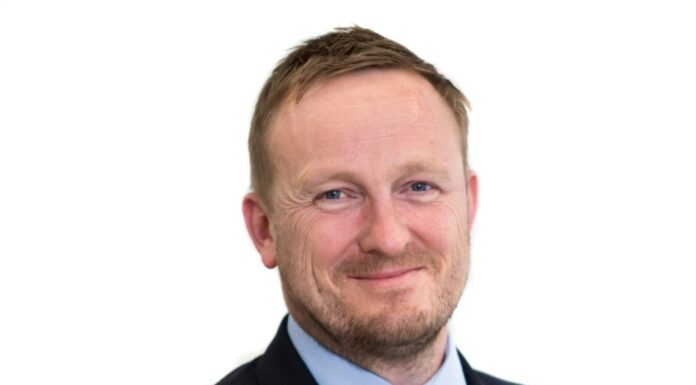KNOWLEDGE AS AN ASSET (FROM DESK TO MANAGEMENT).
Christine Kenny, managing director, senior fixed income strategist, compliance officer and head of the London office at Loomis, Sayles & Co., discusses the move from the trading desk to management and the perspective it gives her on the current trading environment.
What did you learn moving from the trading desk to management?
I knew I was ready to walk away from the transaction part of the business but I chose my timing. Some days I miss the noise. Some days I am thrilled I am not surrounded by it. It depends on the day.
In the trading room, people used to joke that they would have to trade for the rest of their lives, being trained for nothing else. But there are skills you carry over. Whether you have 10 portfolio managers (PMs) coming at you and 100 trades on your blotter, or seven different departments with a variety of needs, you prioritise those to structure your day. Both as a t
rader and in management you are handling internal and external relationships all day long. You just deal with different characters.
What advice would you give someone considering the same move?
Be sure you are ready; you have got to be sure that you are not going to miss that daily adrenalin. You can’t do this precipitously. If you are still thinking about it a year from the day you first considered it, then it is time to do it. Off the desk, understand that everyone has a different personality and approach so – as long as the core view is the same – you have to step back a little bit and let people sort out what works for them. I still keep up with markets but I can’t quote any of the trades that I used to be able to quote off the top of my head. You don’t need to deal with that level of information flow anymore.
How much might a trader experience a jolt in the change of information flow, compared with a PM moving into the same management role?
That probably depends on where you trade. At Loomis the PMs don’t speak to the street, all information comes through the traders. They are the main portal of all relationship management, and I think that differentiates us from a fair number of our peers. The trading desk is the gateway. That gives traders a lot more autonomy at Loomis and also a lot more input into the investment process. There is a feeling of ownership as trading, research and portfolio management all have some level of input into the final decisions, though the ultimate decision lies with the PM.
How do you structure that integration of the desk into the investment process?
We have teams for all the different sectors, each often serving multiple product types, and there is always a trader involved in those meetings along with the PM and along with the appropriate analysts. The trader stares at every little blip all day long so if they are given an order by a PM they have autonomy and ability – unless we have a mandate or a rules issue. They then give the PM alternative scenarios, based on getting it done at the end of the day, the end of the week, or the month, as needed.
How does that work in the primary market?
The same thing happens on new issues. You can get multiple orders for the same new issue at multiple levels. What is seen as good relative value for one type of portfolio may straddle into lesser relative value for another type of portfolio. Our traders really need to know their markets extraordinarily well, and be sure to disseminate all of the relevant information. They are subject matter experts.
What is the impact of that autonomy on the PM?
It keeps the PMs free to focus more on the portfolio construction and the macro views they want to incorporate; the overall sector opinions they want to build in. The traders can give them all the information from the technical side so the PM doesn’t have to be staring at that as well. And then our portfolio specialists, who also work in the trading room, serve as a vital link in strategy implementation – kind of a bridge between traders and PMs. Once the overall strategy decision is made, the specialists create the trade for execution, after taking into account the various rules, guidelines and mandates that all need to be considered.
From your position as a strategist what are the greatest challenges facing buy-side trading desks over the medium- to long-term?
The most pressing challenge is keeping up with regulation. We have global desks in London, in Boston and in Singapore. We tend to go with whatever the most stringent rules are. That means adjusting with new processes, new structures, new systems and getting comfortable with how to manage them. The dealing desk will be the forefront of it and will most likely be the most directly impacted by a lot of the changes.
The counterparties for fixed income markets are changing with market structure across credit and rates, with all-to-all trading and high-frequency trading firms filling the gap for traditional brokers. How much of a concern is that?
It goes back to education; you have to learn how the new counterparties operate. It’s very different across all the desks, even at the traditional broker dealers. You start to learn how to manage each firm, each desk, and each individual on those desks. New counterparties are going to have to pass the same checks as with anyone else but as long as they are registered and regulated theoretically we have no issue with it. New technology offers better ways to police behaviour, so firms are not going to get away with inappropriate behaviour, or not for long.
Should firms develop a strategy to avoid gamesmanship between buy-side and non-traditional sell-side – or is it up to the traders to handle?
The easy answer is, it is part of being a trader and they have to deal with it. With all of these new platforms and initiatives we are going to have the same questions: how do you manage information leakage? How do you manage the gamesmanship, as you put it? Even today you can talk to your sales person on the phone and the sales person next to him hears what you are talking about and mentions it to a client. It’s annoying when the information gets out before you have even finished your first conversation. The new world is going to include some different venues and perhaps different players at the other side of that conversation. We are all just going to have to get smarter.
How do your traders’ skills differentiate the firm?
Our traders are expected to be alpha generators. They are supposed to add value to each portfolio. We develop those skill sets. That is becoming more and more important going forward. It is always hard to measure with a buy-side trader. That’s an ongoing challenge, but getting people in the mind set of adding value in the way they approach trading is going to be important for the buy side in general. We are huge believers in it and practitioners of it. More investment managers will probably follow suit.
What do you use to motivate your trading teams without offering compensation along the lines of a hedge fund or bank?
Having the traders at the table where the decisions are being made and knowing that their voices are being heard. That’s what kept me motivated and I would like to think that’s what motivates others. I know on the sell side the motivation is the P&L and I am sure that is a fair amount of the motivation within hedge funds. We are not that model, nor do I think we would or could adopt that sort of model. It is more that we want our whole team to have a sense of ownership.
With the integration of the traders with the rest of the firm are you seeing any increased use of the data that trading desks collect?
Yes. It used to be that a PM would ask about a particular bond and the trader would tell them, ‘It doesn’t trade that often I could probably get it here’ and give them anecdotal evidence without a ton of figures to back it up. Now the trader can send that data out and they don’t have to have that conversation with six different PMs. They can tell the PMs whether we have history on a name, what the history has been, what has been going on. It speeds up the process. Data is going to be more and more important going forward. The key is grabbing the right data and using it the right way, whether that is for transacting, for transaction cost analysis or for best execution reporting.
With all of the data MiFID II will provide, what should traders be wary of?
Given all of the new things you will have access to after MIFID II comes in, don’t assume that’s all you need. You still need to have your old basics. You can’t forget how the job’s been done for decades and rely too heavily on these new bits of information as the core way you decide things.
There was a change of behaviour that happened with TRACE in the US. That last print became the overriding piece of information that some people quoted as to why they wanted to do something at a certain level. I don’t think it should ever be overriding, because you only know where it traded. You don’t know why it traded. You don’t know the context in which anything was occurring. I think that’s the thing people have to be wary of – it goes back to everything we have to be smart about. Loomis Sayles has some advantages in that we have traders who already know to dig for the full story, so this will just be another piece of information for them.
[Biography] With more than 25 years of experience in the investment industry, Christine Kenny is head of the Loomis Sayles London office, a senior market strategist for the firm’s fixed income group and chief compliance officer. Christine joined LSI’s parent company, Loomis, Sayles & Company in 2001 as a senior trader on the investment grade trading desk. Previously, she was a senior trader at State Street Global Advisors, where she specialized in emerging markets and high yield debt. Christine began her career at Smith Barney. She earned a BA from the College of the Holy Cross and a Masters in International Finance from Brandeis University.
Loomis Sayles has US$232 billion in assets under management across a range of equity, fixed income and alternative investment strategies for institutional and retail clients. The firm has 26 traders in Boston, with two more based in London and one in Singapore, using the Charles River platform for order management.
©The DESK 2016
©Markets Media Europe 2025









